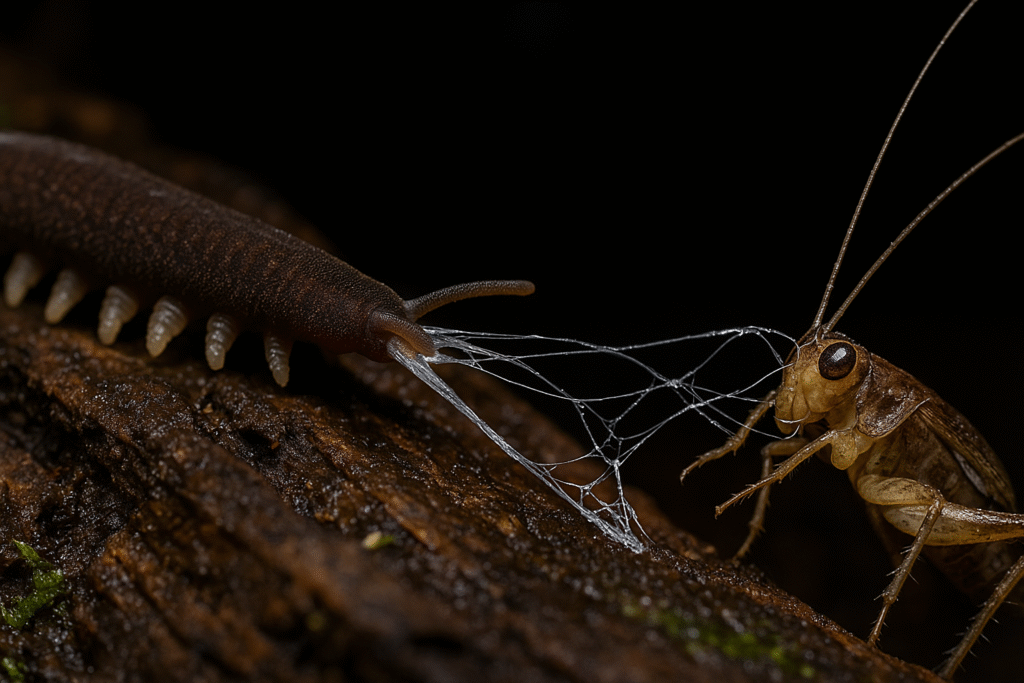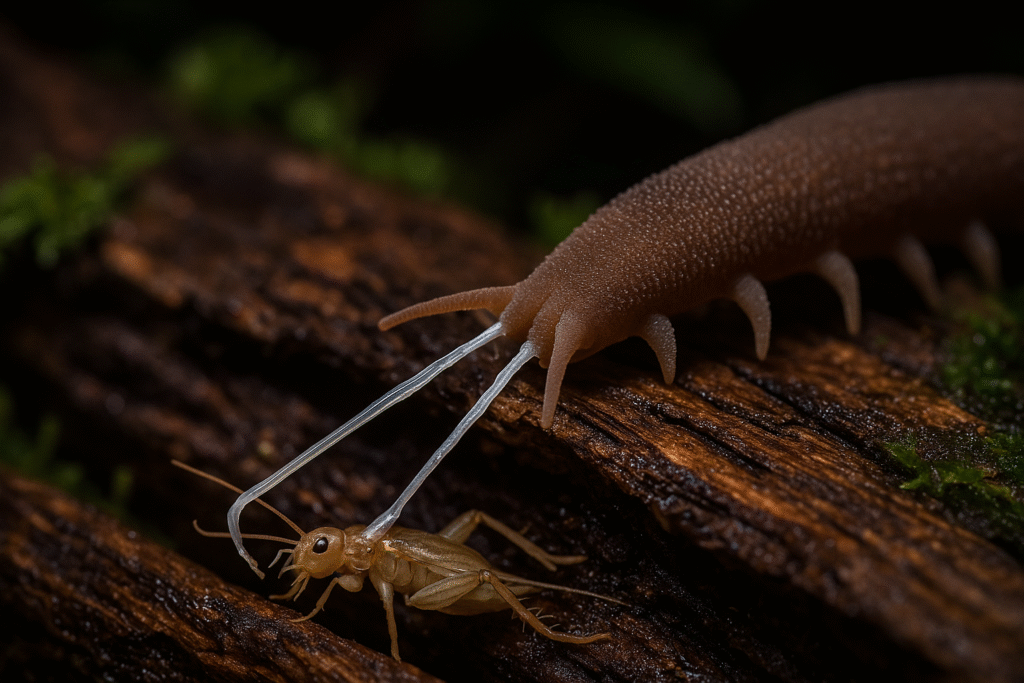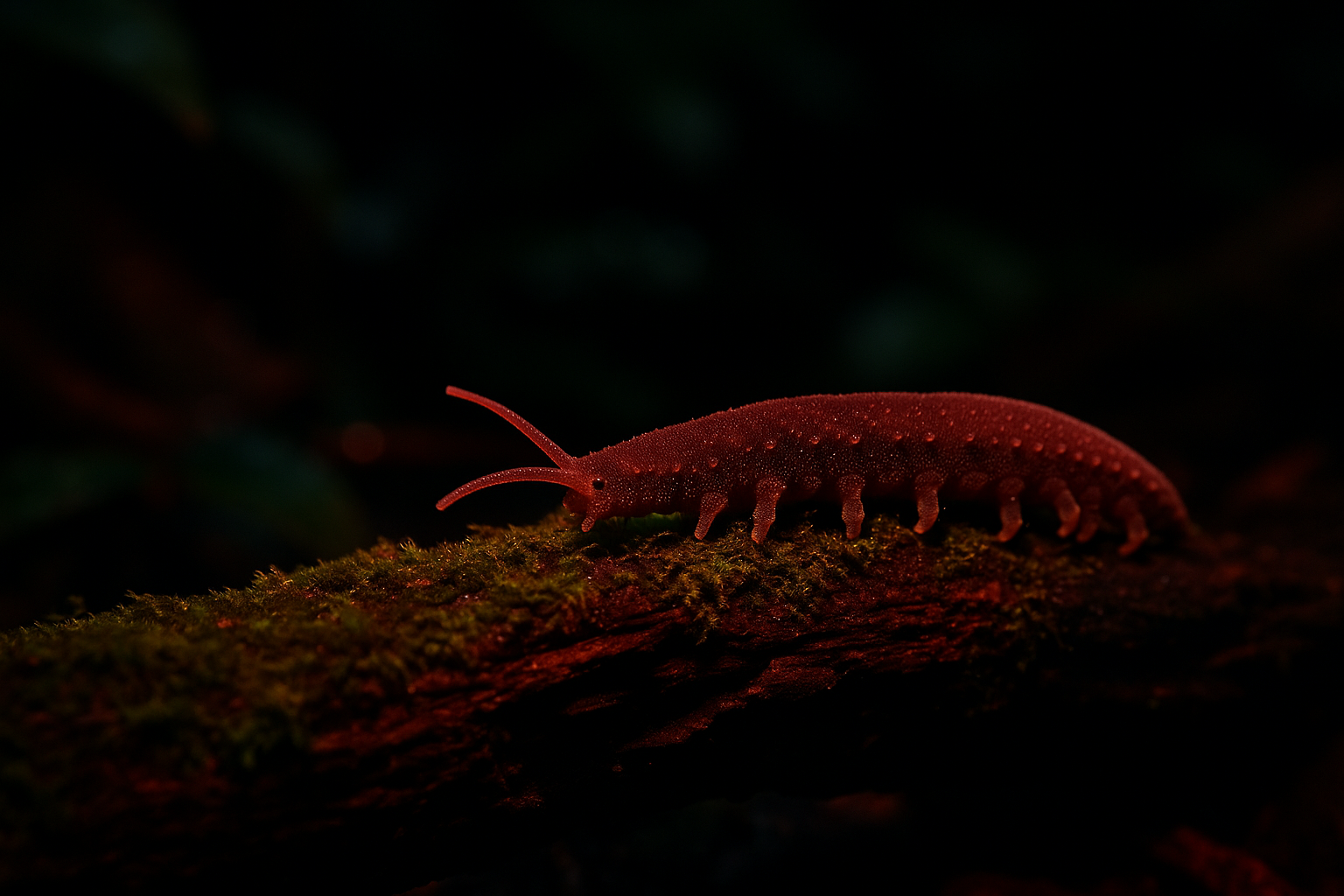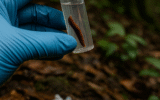Prologue: a hunter the rainforest keeps secret
Open a rotting log after rain and the air turns cool and fungal. What looks at first like a short, velvety strand of licorice begins to move—slowly, deliberately—on dozens of stubby legs. Two flexible antennae palpate the dark. The creature raises a pair of side-mounted nozzles and, with a sudden whiplash, fires twin ribbons of quick-setting glue that lattice the air and stitch a sprinting cricket to the wood. This is a velvet worm, a member of the ancient phylum Onychophora—a living thread that ties the modern rainforest to the Cambrian seafloor. It does not roar, it does not sprint, and yet it is one of nature’s most ingenious predators.
1) Identity: what a velvet worm is (and is not)
Velvet worms are neither worms nor typical insects. They occupy their own phylum, Onychophora, with a body plan unlike anything else alive today.

- Build: soft, cylindrical body, typically 3–15 cm long; a few species reach 20+ cm. The cuticle is thin, velvet-like, and dotted with tiny papillae that give the animal its matte sheen and remarkable flexibility.
- Legs: 13 to 43 pairs of unjointed, stubby lobopods end in tiny claws. They move via peristaltic waves, gripping and releasing like soft tread.
- Headgear: a pair of muscular antennae for navigation, and a mouth armed with sclerotized jaws tucked inside—miniature, opposing “blades” used to pierce prey.
- Signature weapon: the oral papillae, side-mounted tubes that eject twin streams of protein-based adhesive. The slime hits the air, cross-links in seconds, and sets like elastic glass, pinning prey before the jaws ever touch it.
Two major lineages divide the world: Peripatidae (tropical; Americas, West Africa, Southeast Asia) and Peripatopsidae (temperate; Australasia, South Africa, Chile). Within those families, diversity is far higher than field guides once suggested—many species are cryptic and hyper-local.
2) A body written for shadows and drip
Everything about the velvet worm is tuned to humid, stable microclimates. The thin cuticle breathes a little, but it leaks water, so the animal carries the rainforest with it: under bark, in mossy logs, inside soil sponges, where humidity clings to surfaces even during noon heat.
Hydrostatic skeleton. Lacking rigid joints, the body is a pressurized fluid bag ringed with muscle. By tightening one band and releasing another, the worm turns fluid pressure into motion—like a slow, precise hydraulic excavator. The advantage is silence and stability; the disadvantage is speed. A velvet worm rarely outruns anything. It doesn’t need to.
Tracheae and valves. Gas exchange happens through a network of tiny tracheae that open to the surface. Many species can partially close these openings, trading oxygen intake for water conservation. That, plus a slow metabolism, lets them sit for long stretches in a snug crevice and wait for night.
3) The slime cannon: chemistry meets choreography
The hallmark of the velvet worm is projectile glue. The biomechanics are kinetic art:
- Charging: Slime glands in the body store a watery solution rich in elastic, self-assembling proteins.
- Launch: Powerful muscles squeeze the glands. The fluid jets through narrow ducts in the oral papillae.
- Weaving: The worm rapidly flicks the papillae left-right, braiding two jets into a zigzag lattice.
- Set: As the strands thin in air, proteins cross-link, forming a stretchy network that adheres to cuticle, wood, or leaf.
- Reload: After subduing and feeding, the worm can re-dissolve and re-ingest much of the glue—recycling precious protein in an environment where nitrogen is not free.
This weapon is nonlethal and reusable, the rainforest equivalent of a bola. Prey is immobilized, not crushed; the jaws then pierce the exoskeleton and inject saliva that digests tissues from the inside out. Feeding is measured, almost surgical.
4) Deep time lineage: from lobopodians to velvet
Velvet worms share ancestry with the strange Cambrian lobopodians seen in fossil beds—soft-bodied, many-legged creatures that swam or crawled half a billion years ago. Their living relatives form a triad of major molting animal groups: arthropods (insects, spiders, crustaceans), onychophorans (velvet worms), and tardigrades (water bears). The velvet worm stands as a transitional echo: a soft, flexible lobopodian that never hardened into an arthropod shell, carrying a body plan that predates forests themselves.

Calling them “living fossils” undersells their success. They have innovated—evolved adhesive weapons, complex reproduction, even social behaviors—while keeping a form that works wherever darkness and moisture persist.
5) Social lives in the slow lane
Velvet worms were long portrayed as solitary. Careful night work told a subtler story.
- Family groups: Some species shelter as small groups in a shared log, often an adult female with juveniles.
- Dominance and feeding order: In several peripatids, females lead, juveniles feed first on small captured prey, and dominant adults take prime positions on larger catches. Communication appears tactile and chemical; antennae strokes matter.
- Cooperative hunting (rare but real): When prey is abundant, two or more worms may converge on the same target and weave a combined net that sets faster and stronger than one worm’s alone.
These behaviors minimize waste and conflict in a world where energy is dear. Even hierarchy serves hunger: a pecking order prevents the kind of fight that would tear skin and spill water.
6) Reproduction: from eggs to placenta-like nutrition
If the slime cannon is the flashy story, reproduction is the quiet revolution. Across the two families, velvet worms display all three major reproductive modes known to terrestrial invertebrates:
- Oviparity (egg-laying): Common in temperate Peripatopsidae. Eggs are shelled and deposited in snug, humid chambers.
- Ovoviviparity: Eggs hatch inside the female; young are birthed live but nourished primarily by yolk.
- Viviparity with matrotrophy: In many tropical Peripatidae, embryos receive extra nutrition from the mother beyond yolk, delivered through specialized uterine tissues—an analog to a placenta. The mother invests heavily; the brood is smaller but robust.
Courtship is equally inventive. In some species, spermatophores are placed onto the female’s skin; immune cells dissolve a small patch of cuticle and escort sperm into the body—an extraordinary “shortcut” through the integument. In others, sperm is transferred to the genital opening in more conventional fashion. Either way, timing is tuned to seasons of moisture and prey.
7) Geography: dots on a damp map
Velvet worms are scattered across the southern continents and tropical belts in a pattern that mirrors the legacy of ancient landmasses:
- Australasia: Australia, Tasmania, and New Zealand hold a rich array, including iconic “peripatus” species that became local legends.
- Southern Africa: Pockets survive in Afromontane forests and coastal thickets.
- Neotropics: From Mexico through Central America into the Andean foothills and Atlantic forests of South America.
- Southeast Asia and islands: Patchy records in rainforest remnants.
Within these broad regions, many species exist as hyper-local endemics—one valley, one hillside, one band of cloud forest. Clear a ridge and an entire genetic library can vanish.
8) Ecology and diet: what the slow hunter eats
Velvet worms target small arthropods—crickets, cockroaches, termites, woodlice, millipede juveniles—plus soft-bodied invertebrates that share their microhabitat. They hunt by probing with antennae, then firing when motion and scent register prey within a body-length or two. The glue is effective even on slick chitin, and the zigzag aim anticipates escape paths, laying a tangle just ahead of a fleeing insect.
Because they are moisture-dependent, velvet worms often hunt on humid nights, returning to their refuges before dawn. Predators include spiders, centipedes, beetles, small reptiles, and—where introduced—rats. Their best defense remains the refuge itself: deep, water-holding cavities that stay stable when the forest surface swings hot–cold, wet–dry.
9) Engineering lessons from a rainforest artisan
Nature’s adhesives inspired a generation of materials science, and velvet-worm slime is a model system for reversible, recyclable glues:
- Shear-thinning jet: The fluid leaves the nozzle runny, allowing long-range projection through tiny tubes.
- Rapid cross-linking: As the jet thins in air, protein strands align and interlock, forming an elastic solid within seconds.
- Water-triggered reset: Later rehydration reverses much of the process; the worm reclaims and reuses the proteins.
Engineers study these properties to design bioinspired fibers, sprayable sealants, and non-toxic capture media. The lesson is not merely stickiness; it’s control—how to turn a liquid into a lattice exactly when and where you want it.
10) Conservation: the small disasters that erase entire lineages
Velvet worms do not need a chainsaw to disappear; a single felled log or a drained gully can erase a population if that log or gully held their last, wet refuge. Their core risks:
- Deforestation and fragmentation: Sun and wind penetrate; humidity drops; logs dry out. The microclimate fails before the animals starve.
- Urbanization and tidy forestry: “Clean” parks that remove dead wood become deserts for saproxylic life.
- Fire regimes and drought: Heat pulses desiccate shallow refuges.
- Invasive predators: Rats and certain ants can empty pockets quickly.
- Overcollection: Their charisma tempts hobbyists; removing a handful from a tiny population can matter.
Practical protection is refreshingly concrete: leave coarse woody debris on the forest floor, maintain shaded, moist corridors, forbid daylighting of streams in remnant gullies, and route trails around known refuges. In cities, velvet worms sometimes persist in mature gardens with damp mulch and old timbers; protecting these micro-islands costs almost nothing and preserves a piece of deep time.
11) Fieldcraft: how to look without harm
If your climate and region are right, careful night searches can reveal velvet worms—ethically.
- Timing: After rain, during humid, still nights.
- Method: Lift loose bark and already-dislodged branches; never pry tight bark off living trees. Replace everything precisely as found.
- Handling: If you must move one (for a photo), moistened hands and minimal contact; never keep them.
- Leave no desert: Avoid exposing fresh wood to air; seal back crevices with the same bark to conserve humidity.
- Record, don’t publish precise sites: Share generalized locations with local biodiversity projects; protect exact refuges from casual collectors.
The goal is to learn and leave whole.
12) Why velvet worms matter (beyond cool slime)
- Evolutionary significance: They anchor a branch of animal life that helps explain how arthropods emerged—soft-bodied, many-legged ancestors stepping toward the exoskeleton world.
- Design inspiration: Reversible adhesives, soft robotics (hydraulic movement without joints), and non-lethal capture systems all draw from their biology.
- Ecosystem function: As mid-level predators in the litter layer, they filter swarms of small arthropods and turn them into nutrients that larger animals can use.
- Cultural value: Their existence changes how we read a forest: biodiversity is not only birds and trees; it is humidity held between bark and heartwood, a whole universe inside a single log.
13) Myths to retire—and truths to keep
- Myth: “They’re primitive.”
Truth: They are specialists refined for humidity and stealth, with unique weapons and complex reproduction. - Myth: “They’re insects.”
Truth: They are onychophorans, their own phylum, sister to arthropods and tardigrades. - Myth: “They’re rare everywhere.”
Truth: Many species are locally common where habitat persists; they are rarely seen because we rarely look where they live. - Myth: “Any forest will do.”
Truth: They need constant moisture and three-dimensional refuges—old logs, deep litter, mossy seams. A “green” forest without these is empty habitat.
14) A practical checklist for land managers
- Keep dead wood—whole logs, not just chips.
- Retain shaded ravines and closed canopies over moist gullies.
- Avoid “clean-up” after storms; stack fallen limbs to preserve humidity pockets.
- Buffer seeps and springs; do not straighten or expose them.
- Manage fire to protect damp refuges; use mosaics, not blanket burns.
- In urban parks, designate no-rake zones with interpretive signs that explain why “messy” patches are biodiversity engines.
These micro-decisions turn paper parks into living ones.

15) Closing: patience, pressure, precision
The velvet worm wins by refusing the race. It lives slowly in a pressurized body, hunts with a lattice of self-setting silk, feeds by chemistry rather than force, and raises its young in darkness with the careful timing of a metronome that follows rain. To find one is to discover how much life hides inside slowness—and how much future we can lose by tidying the forest floor.
Leave the next log as you found it. Somewhere inside, a creature older than leaves is waiting for night, antennae testing the damp, slime glands full, perfectly unhurried in a world that keeps telling everything to hurry.


Reply